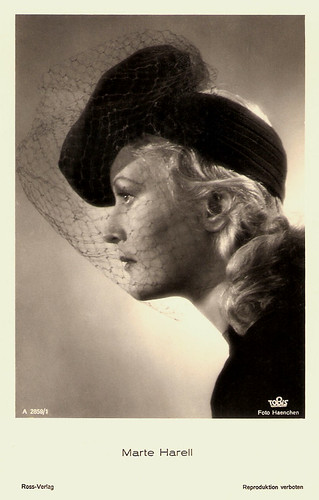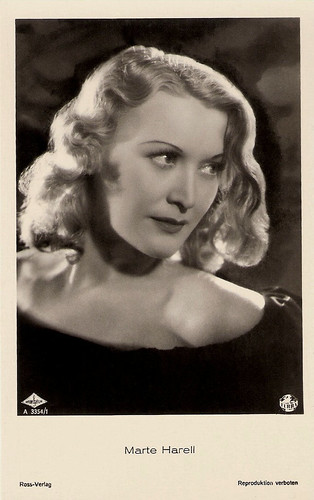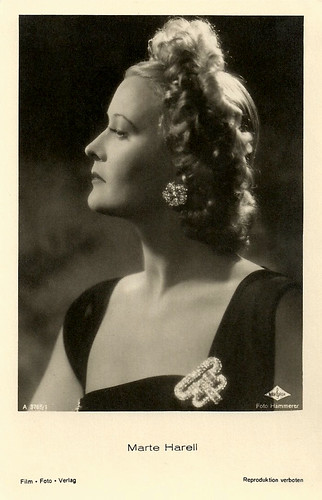Austrian actress Marte Harell (1907-1996) played strong women who determined the events, in several Viennese comedies and operettas of the 1940s and 1950s.

German postcard by Ross Verlag, no. A 2858/2, 1939-1940. Photo: Haenchen / Tobis.

German postcard by Ross Verlag, no. A 2859/1, 1939-1940. Photo: Haenchen / Tobis.

German postcard by Ross Verlag, no. A 3354/1, 1941-1944. Photo: Wien Film / Terra.

German postcard by Film-Foto-Verlag, no. A 3765/1, 1941-1944. Photo: Hämmerer / Wien Film.
Marte Harell was born Martha Schömig in Wien (Vienna), Austria-Hungary, now Austria in 1907. She was the daughter of architect Rudolf Schömig and his wife Emilie Mathilde Passetzky.
Marte visited a secondary school for girls in Vienna. Her acting career started when she married director Karl Hartl in 1930. She followed acting classes from Margit von Tolnai and attended the Max-Reinhardt Seminar.
At 30, she made her debut at the Kammerspielen des Theaters in der Josefstadt. She worked for theatres in Munich and Berlin, where she was spotted by director Géza von Bolváry at the Deutsches Theater.
He asked her for the leading lady role in his film Opernball/Opera Ball (Géza von Bolváry, 1939) opposite Paul Hörbiger. Her film debut at 32 as the typical 'Wiener mädel' (Viennese girl) became an unexpected success.
More leading roles followed in Wiener G'schichten/Vienna Tales (Géza von Bolváry, 1940) again opposite Paul Hörbiger and an adaption of the Carl Zeller Operetta 'Der Vogelhändler', Rosen in Tirol/The Bird Seller (Géza von Bolváry, 1940) with Johannes Heesters.

German postcard by Ross Verlag, no. A 3109/1, 1941-1944. Photo: Haenchen / Tobis.

German postcard by Ross Verlag, no. A 3109/2, 1941-1944. Photo: Wien-Film.

German postcard by Ross Verlag, no. A 3206/2, 1941-1944. Photo: Wien Film / Terra.

German postcard by Film-Foto-Verlag, no. A 3765/2, 1941-1944. Photo: Hämmerer / Wien-Film.

German postcard by Film-Foto-Verlag, no. A 3934/1, 1941-1944. Photo: Hämmerer / Wien-Film.
Marte Harell became very busy as an actress for the newly founded Wien-Film, when her husband, Karl Hartl, became the production manager of this company.
She convinced critics and audiences with her performances in Brüderlein fein/Dear Brother (Hans Thimig, 1941), the comedy Die heimliche Gräfin/The Secret Countess (Géza von Bolváry, 1942) with Wolf Albach-Retty, Frauen sind keine Engel/Women Are No Angels (Willi Forst, 1943) with a young Curd Jürgens, and Tolle Nacht/Great Night (Theo Lingen, 1943).
She always played the strong woman who determined the events and was not able to hide her typical Viennese accent. The part of Fiakermilli (Cabby Milli) in the beautiful tragi-comedy-musical Schrammeln (Géza von Bolváry, 1944) was her most popular role. For the adaptation of Johann Strauss' comic opera Die Fledermaus/The Bat (1945), she worked again with director Géza von Bolváry, with whom she would make a total of ten films.
Harell continued her film career immediately after the Second World War with Glaube an mich/Believe in Me (Géza von Cziffra, 1946), but the film was torn to pieces by the critics. Two years later she returned in the romance Nach dem Sturm/After the Storm (Gustav Ucicky, 1948), based on a story by Carl Zuckmeyer.
Wien Tanzt/Vienna Waltzes (Emil E. Reinert, 1951) was an old-fashioned musical extravaganza in the tradition of pre-war Austrian films. The story centres upon Waltz King Johann Strauss (Adolf Wohlbrück) and his ‘progressive’ composer son Richard, and their terrific music. About the female lead, Hal Erickson wrote at AllMovie: “The feminine interest in Wien Tanzt is provided by Marte Harell, who refreshingly is not a Hollywood-style glamourpuss.”

Austrian postcard by Eberle Verlag, Wien, no. 21. Photo: I.S.B. Films.

German postcard by Film-Foto-Verlag, no. G 141, 1941-1944. Photo: Hämmerer / Wien-Film.

German postcard by Film-Foto-Verlag, no. G 220, 1941-1944. Photo: Hämmerer / Wien-Film.

German postcard by Ross. Photo: Terra / Baumann.
In 1951, the Austrian public chose Marte Harell as the most popular actress, but her film roles became rarer during the 1950s. In between, she had a successful stage comeback and dedicated herself again to the theatre.
She appeared in one film a year, among others the comedy Liebeskrieg nach Noten/Love War for Music (Karl Hartl, 1953) with Johannes Heesters, the historical thriller Spionage/Espionage (Franz Antel, 1955) based on the tragic life story of the homosexual ‘Oberst’ Alfred Redl, and the operetta Im Prater blühn wieder die Bäume/Trees Are Blooming in Vienna (Hans Wolff, 1958).
Her last films were the spy yarn Assignment K (Val Guest, 1968) starring Stephen Boyd, Abenteuer eines Sommers/Summer Adventure (Helmut Pfandler, 1974) starring Matthias Habich, the sex comedy Das Love-Hotel in Tirol/Love Hotel in Tyrol (Franz Antel, 1978), and the historical drama Der Bockerer (Franz Antel, 1980), about the naïve Viennese butcher Karl Bockerer who refuses to get assimilated by the Nazi system and with his aggressive but charming behaviour, and a whole lot of luck, survives the war.
During the 1970s, Marte Harell also worked regularly for television and made guest appearances in series like Hallo – Hotel Sacher… Portier!/Hello – Hotel Sacher… Doorman! (1973), Van der Valk und die Reichen/Van der Valk and the Rich (1975), and the popular Krimi Tatort (1974). In 1985, she was awarded the Filmband in Gold for her longtime and important contributions to German cinema, and that same year she retired.
In 1996, Marte Harell died in Vienna. Her husband, Karl Hartl, had passed away in 1978. In 1951 the couple was divorced, but eight years later they remarried. In 2000 a street was named after her, the Marte-Harell-Gasse in Wien-Liesing.
Scene with Heli Finkenzeller, Theo Lingen and Marte Harell from Opernball/Opera Ball (1939). Source: BD130 (YouTube).
Clips with Marte Harell, Willy Fritsch and Johannes Heesters from Die Fledermaus/The Bat (1944). Source: Fritz 5108 (YouTube).
Another, long scene from Die Fledermaus/The Bat (1944-1945, but released in 1946), with Dorit Kreysler, Hans Brausewetter, Johannes Heesters, Marte Harell, Siegfried Breuer, Will Dohm, and Willy Fritsch. Source: Atqui (YouTube).
The final scene from Rosen in Tirol/The Bird Seller (1940) with Marte Harell, Johannes Heesters and Hans Moser. Source: Ein Lied Geht um die Welt (YouTube).
Sources: Thomas Staedeli (Cyranos), Hal Erickson (AllMovie - Page now defunct), Stephanie D’heil (Steffi-Line - German), Wikipedia (German) and IMDb.
This post was last updated on 13 August 2024.

German postcard by Ross Verlag, no. A 2858/2, 1939-1940. Photo: Haenchen / Tobis.

German postcard by Ross Verlag, no. A 2859/1, 1939-1940. Photo: Haenchen / Tobis.

German postcard by Ross Verlag, no. A 3354/1, 1941-1944. Photo: Wien Film / Terra.

German postcard by Film-Foto-Verlag, no. A 3765/1, 1941-1944. Photo: Hämmerer / Wien Film.
Wiener mädel
Marte Harell was born Martha Schömig in Wien (Vienna), Austria-Hungary, now Austria in 1907. She was the daughter of architect Rudolf Schömig and his wife Emilie Mathilde Passetzky.
Marte visited a secondary school for girls in Vienna. Her acting career started when she married director Karl Hartl in 1930. She followed acting classes from Margit von Tolnai and attended the Max-Reinhardt Seminar.
At 30, she made her debut at the Kammerspielen des Theaters in der Josefstadt. She worked for theatres in Munich and Berlin, where she was spotted by director Géza von Bolváry at the Deutsches Theater.
He asked her for the leading lady role in his film Opernball/Opera Ball (Géza von Bolváry, 1939) opposite Paul Hörbiger. Her film debut at 32 as the typical 'Wiener mädel' (Viennese girl) became an unexpected success.
More leading roles followed in Wiener G'schichten/Vienna Tales (Géza von Bolváry, 1940) again opposite Paul Hörbiger and an adaption of the Carl Zeller Operetta 'Der Vogelhändler', Rosen in Tirol/The Bird Seller (Géza von Bolváry, 1940) with Johannes Heesters.

German postcard by Ross Verlag, no. A 3109/1, 1941-1944. Photo: Haenchen / Tobis.

German postcard by Ross Verlag, no. A 3109/2, 1941-1944. Photo: Wien-Film.

German postcard by Ross Verlag, no. A 3206/2, 1941-1944. Photo: Wien Film / Terra.

German postcard by Film-Foto-Verlag, no. A 3765/2, 1941-1944. Photo: Hämmerer / Wien-Film.

German postcard by Film-Foto-Verlag, no. A 3934/1, 1941-1944. Photo: Hämmerer / Wien-Film.
Not a Hollywood-style glamourpuss
Marte Harell became very busy as an actress for the newly founded Wien-Film, when her husband, Karl Hartl, became the production manager of this company.
She convinced critics and audiences with her performances in Brüderlein fein/Dear Brother (Hans Thimig, 1941), the comedy Die heimliche Gräfin/The Secret Countess (Géza von Bolváry, 1942) with Wolf Albach-Retty, Frauen sind keine Engel/Women Are No Angels (Willi Forst, 1943) with a young Curd Jürgens, and Tolle Nacht/Great Night (Theo Lingen, 1943).
She always played the strong woman who determined the events and was not able to hide her typical Viennese accent. The part of Fiakermilli (Cabby Milli) in the beautiful tragi-comedy-musical Schrammeln (Géza von Bolváry, 1944) was her most popular role. For the adaptation of Johann Strauss' comic opera Die Fledermaus/The Bat (1945), she worked again with director Géza von Bolváry, with whom she would make a total of ten films.
Harell continued her film career immediately after the Second World War with Glaube an mich/Believe in Me (Géza von Cziffra, 1946), but the film was torn to pieces by the critics. Two years later she returned in the romance Nach dem Sturm/After the Storm (Gustav Ucicky, 1948), based on a story by Carl Zuckmeyer.
Wien Tanzt/Vienna Waltzes (Emil E. Reinert, 1951) was an old-fashioned musical extravaganza in the tradition of pre-war Austrian films. The story centres upon Waltz King Johann Strauss (Adolf Wohlbrück) and his ‘progressive’ composer son Richard, and their terrific music. About the female lead, Hal Erickson wrote at AllMovie: “The feminine interest in Wien Tanzt is provided by Marte Harell, who refreshingly is not a Hollywood-style glamourpuss.”

Austrian postcard by Eberle Verlag, Wien, no. 21. Photo: I.S.B. Films.

German postcard by Film-Foto-Verlag, no. G 141, 1941-1944. Photo: Hämmerer / Wien-Film.

German postcard by Film-Foto-Verlag, no. G 220, 1941-1944. Photo: Hämmerer / Wien-Film.

German postcard by Ross. Photo: Terra / Baumann.
Most popular actress
In 1951, the Austrian public chose Marte Harell as the most popular actress, but her film roles became rarer during the 1950s. In between, she had a successful stage comeback and dedicated herself again to the theatre.
She appeared in one film a year, among others the comedy Liebeskrieg nach Noten/Love War for Music (Karl Hartl, 1953) with Johannes Heesters, the historical thriller Spionage/Espionage (Franz Antel, 1955) based on the tragic life story of the homosexual ‘Oberst’ Alfred Redl, and the operetta Im Prater blühn wieder die Bäume/Trees Are Blooming in Vienna (Hans Wolff, 1958).
Her last films were the spy yarn Assignment K (Val Guest, 1968) starring Stephen Boyd, Abenteuer eines Sommers/Summer Adventure (Helmut Pfandler, 1974) starring Matthias Habich, the sex comedy Das Love-Hotel in Tirol/Love Hotel in Tyrol (Franz Antel, 1978), and the historical drama Der Bockerer (Franz Antel, 1980), about the naïve Viennese butcher Karl Bockerer who refuses to get assimilated by the Nazi system and with his aggressive but charming behaviour, and a whole lot of luck, survives the war.
During the 1970s, Marte Harell also worked regularly for television and made guest appearances in series like Hallo – Hotel Sacher… Portier!/Hello – Hotel Sacher… Doorman! (1973), Van der Valk und die Reichen/Van der Valk and the Rich (1975), and the popular Krimi Tatort (1974). In 1985, she was awarded the Filmband in Gold for her longtime and important contributions to German cinema, and that same year she retired.
In 1996, Marte Harell died in Vienna. Her husband, Karl Hartl, had passed away in 1978. In 1951 the couple was divorced, but eight years later they remarried. In 2000 a street was named after her, the Marte-Harell-Gasse in Wien-Liesing.
Scene with Heli Finkenzeller, Theo Lingen and Marte Harell from Opernball/Opera Ball (1939). Source: BD130 (YouTube).
Clips with Marte Harell, Willy Fritsch and Johannes Heesters from Die Fledermaus/The Bat (1944). Source: Fritz 5108 (YouTube).
Another, long scene from Die Fledermaus/The Bat (1944-1945, but released in 1946), with Dorit Kreysler, Hans Brausewetter, Johannes Heesters, Marte Harell, Siegfried Breuer, Will Dohm, and Willy Fritsch. Source: Atqui (YouTube).
The final scene from Rosen in Tirol/The Bird Seller (1940) with Marte Harell, Johannes Heesters and Hans Moser. Source: Ein Lied Geht um die Welt (YouTube).
Sources: Thomas Staedeli (Cyranos), Hal Erickson (AllMovie - Page now defunct), Stephanie D’heil (Steffi-Line - German), Wikipedia (German) and IMDb.
This post was last updated on 13 August 2024.
No comments:
Post a Comment